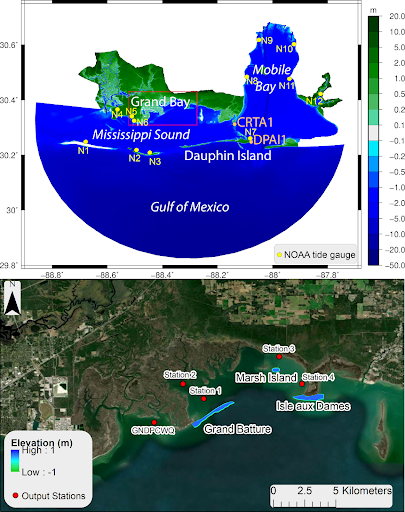An interdisciplinary science team leveraged support from NOAA, USGS, and the Gulf Coast Ecosystem Restoration Council (RESTORE) to complete an evaluation for how restoring headland structures would impact the Grand Bay National Estuarine Research Reserve. Results from the recent study provide insight into how large-scale restoration projects alter water chemistry, coastal habitat, and water movement within an estuary and how those alterations can change under sea level rise.

Large-scale restoration projects that include restoring lost coastline, have the potential to provide habitat and protection from flooding and erosion, though they also can have negative impacts on things like water quality and habitat. These types of research projects are necessary to guide intelligent investment in coastal protection and habitat restoration and ensure the designed projects have longevity that is cost effective and provide long term benefits. Two companion studies led by Dr. Davina Passeri and Rob Jenkins and colleagues provide important information on the potential impacts of proposed interior headland restoration on tidal hydrodynamics, salinity, and sediment transport under present-day conditions and future sea level rise (SLR).
The team used Delft3D to model three proposed interior headland structures, which are transient features connected to shore, but that extend out into the bay or ocean inside of a barrier island (i.e., Figure 1, remnant Grand Batture Islands). These features can be observed as smaller features or large features like those considered in this study. The study revealed that the restored headlands sheltered the marsh shorelines from waves, and there were small, localized changes in tidal currents, average salinity concentrations and bed morphology in the vicinity of the headlands. These changes in salinity could be impactful to oysters or other species such as submerged aquatic vegetation, but will require further study to determine what level of impact. The headland features also acted as a sediment source to the immediate surroundings, while also providing some non-significant sheltering effect of backshore shoals and marsh shorelines. However, regardless of the proposed restoration actions, the greatest sediment fluxes remained directed out of the estuary (exporting sediment), which was shown to increase by 30% under 0.5 m of SLR. This indicates that any restored headland would still erode over time.
This project is led by Dr. Davina Passeri of U.S. Geological Survey St. Petersburg Coastal and Marine Science Center. This project was partially funded as part of NCCOS’s Effects of Sea Level Rise (ESLR) Program; find out more about the project here. This study was also funded in part by The Gulf Coast Ecosystem Restoration Council (RESTORE), and the USGS Coastal & Marine Hazards in Resources Program. This research is a great example of how NOAA supported science served as a foundation that was used to evaluate applied questions that may inform coastal management in the gulf region.
The full list of collaborators can be found in the citation below:
Tidal hydrodynamic and salinity modeling: Passeri Davina L., Jenkins Robert L., Poisson Autumn, Bilskie Matthew V., Bacopoulos Peter. 2023.Modeling the effects of large-scale interior headland restoration on tidal hydrodynamics and salinity transport in an open coast, marine-dominant estuary. Frontiers in Marine Science, 10. 10.3389/fmars.2023.1193462
Sediment transport modeling: Jenkins Robert L., Passeri Davina L., Smith Christopher G., Thompson David M., Smith Kathryn E. L. 2023. Modeling the effects of interior headland restoration on estuarine sediment transport processes in a marine-dominant estuary. Frontiers in Marine Science, 10.10.3389/fmars.2023.1217830.
